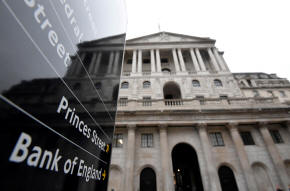Calling time on QE, central banks prep for synchronized asset cull
 Send a link to a friend
Send a link to a friend
 [April 19, 2022] By
Howard Schneider and William Schomberg [April 19, 2022] By
Howard Schneider and William Schomberg
(Reuters) - Major central banks, already
plotting interest rate hikes in a fight against inflation, are also
preparing a common pullback from key financial markets in a first-ever
round of global "quantitative tightening" expected to restrict credit
and add stress to an already-slowing world economy.
The U.S. Federal Reserve and its major counterparts in Europe, Japan,
the United Kingdom and elsewhere pumped around $12 trillion into the
financial system to fight the economic fallout of the coronavirus
pandemic, buying an array of assets and in some cases offering long-term
loans to banks in a massive bout of quantitative easing.
With breakout inflation now the common fear, they are reversing course.
Morgan Stanley analysts recently estimated the Fed, Bank of England,
European Central Bank and Bank of Japan could see their portfolios
shrink by $2.2 trillion over the 12 months beginning in May - the
expected peak of QE.
Graphic: The tide recedes - https://graphics.reuters.com/GLOBAL-ECONOMY/QT/movanbxnypa/chart.png
The estimates are preliminary, and the Fed in particular may prove more
aggressive if, as many analysts expect, it shifts later this year from
letting maturing securities simply expire to outright sales of some
assets to speed the process.

It is a unique moment. The 2007-2009 global financial crisis also
unleashed a wave of QE, but the following recoveries were never strong
enough or provoked enough inflation to prompt a synchronized monetary
tightening.
By removing powerful central bank buyers from markets important to
setting global interest rates, like U.S. Treasuries, the spillovers
could matter.
"We need a tightening of financial conditions...But it is possible we
will see changes in rates or changes in the balance sheet that induce
more of an effect on financial conditions than we think will happen,"
said Karen Dynan during a presentation
https://urldefense.com/v3/__
https://www.piie.com/events/global-economic-prospects-spring-2022__;!!
GFN0sa3rsbfR8OLyAw!I5PO5OHycXXyf5qSo
3XRpPZMfLXxiHynFJaYt4m
Uyb6mLVGJFEheXYfUnNGa_
dCoDdi1Q0nRKGk$ at the Peterson Institute for International Economics,
where she is a senior fellow. One risk is if QT's impacts are felt in
weaker economies with high debt levels and "cause a ripple of sovereign
debt crises around the world that disrupts markets" and further tightens
conditions in developed nations.
'VERY LITTLE EXPERIENCE OF QT'
The World Bank and International Monetary Fund meet this week in
sessions dominated by an interlocking set of problems that led the IMF
to reveal last week it would cut its global growth outlook for the
second time this year.
The pandemic continues to reshape global commerce with major parts of
the Chinese economy on lockdown; the war in Ukraine has become a
humanitarian tragedy influencing flows of fuel, food and industrial
minerals worldwide; and inflation is surging to multi-decade highs,
prompting developed-world central banks to align to quash it.

Graphic: Inflation becomes a common risk -
https://graphics.reuters.com/GLOBAL-ECONOMY/CENBANKS/
gkvlgazoqpb/chart.png
The aim of tighter monetary policy is to slow demand, particularly for
credit-sensitive items like homes and autos, and to ease price pressures
in doing so.
"A lot of the inflation is across the globe...certainly in key producing
regions including Europe," St. Louis Fed President James Bullard said
earlier this month. "We don't want to be feeding the inflation
process...Naturally a lot of central banks are pulling back all at the
same time. That is appropriate."
[to top of second column] |

The Bank of England (BoE) building is reflected in a sign, after the
BoE became the first major world's central bank to raise rates since
the coronavirus disease (COVID-19) pandemic, London, Britain,
December 16, 2021. REUTERS/Toby Melville

Adding QT to interest rate hikes is, however, a wild card. Policymakers and
economists know the general impact - interest rates will be higher than
otherwise - but the exact outcome is uncertain.
"There is very little experience of QT. There is none here and not much
globally," Bank of England Governor Andrew Bailey said in March.
The BoE is already letting its balance sheet decline through passive means: As
bonds mature, instead of reinvesting the proceeds and maintaining the level of
cash in the financial system, it in effect deletes the money from its account
and the wider economy - reversing the initial money creation done by QE - and
the central bank's balance sheet declines.
The BoE has said it will start to consider actively selling assets once it has
taken its bank rate to 1.0%. Investors expect a 25 basis-point hike to 1% on May
5.
The ECB so far has only committed to stopping net asset purchases later this
year. Its balance sheet may still decrease in coming months if banks repay
long-term loans, as many analysts expect. Some smaller players like the Bank of
Canada have also halted reinvestment.
The Bank of Japan is not at the point of tightening, but has been slowing asset
purchases.
'RISK OF A MISSTEP'
By far the biggest player, the Fed is expected to finalize its plans at a
meeting in early May. Minutes of its March discussion said policymakers had
largely agreed to cut up to $95 billion monthly from their holdings, about $1.1
trillion annually.
What it adds up to depends partly on how markets react. The Fed from 2017 to
2019 trimmed its balance sheet by about $650 billion, but that led to a shortage
of banking system reserves, a spike in short-term interest rates, and a quick
reversal to put liquidity - quickly - back into the system.

Fed policymakers view that as a lesson learned and say they expect the process
to run smoothly this time. But it did show mistakes can happen.
The aim of bond buying is to help central banks overcome the impact of low
interest rates, allowing them to add stimulus even after policy rates are cut to
zero. The same logic now lets them withdraw economic support faster than through
raising rates alone. Oxford Economics' Adam Slater estimates balance sheet
reductions in major economies could add the equivalent of as much as 1.3
percentage points to coming rate hikes.
Graphic: Balance sheet tightening impact - https://graphics.reuters.com/GLOBAL-ECONOMY/QT/egvbkbzknpq/chart.png
"The new environment of massive central bank balance sheet operations means
looking at tightening cycles just in terms of policy rates yields a very
incomplete picture," Slater wrote. "In our view, the risk of a misstep over the
next one to two years is perhaps higher than at any time since the 1980s."
The outcome back then? An aggressive fight against inflation triggered a
recession.
(Reporting by Howard Schneider; Additional reporting by Balazs Koranyi in
Frankfurt, William Schomberg in London, Leika Kihara in Tokyo and Julie Gordon
in Ottawa; Editing by Dan Burns and Andrea Ricci)
[© 2022 Thomson Reuters. All rights
reserved.]This material may not be published,
broadcast, rewritten or redistributed.
Thompson Reuters is solely responsible for this content.
 |